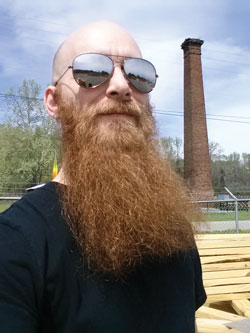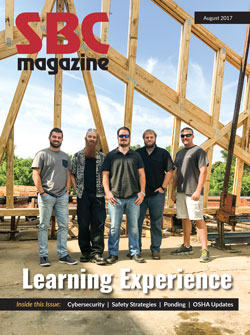Faces of the Industry: Thom Patton
Faces of the Industry: Thom Patton
 SBC Magazine heard about you—and this project—through LinkedIn. Why did you post this?
SBC Magazine heard about you—and this project—through LinkedIn. Why did you post this?
I love to talk about what I do! And I felt my profile needed a little more flair. I didn’t have anything showcasing my skills or letting my network know that being a truss designer is the best job there is. I am either trying to teach people or subconsciously recruiting for the component industry. Besides, it’s a great chance to hone your craft with a focused group. If you’ve taken any missteps, some random peer is sure to come along and bust you! It’s a perfect check-and-balance system.
Sounds like you’re comfortable getting comments on your designs.
Constructive criticism is a great way to discuss running issues, not just fix them. There seems to be an overbearing mindset, at times, when it comes to design methodology. We designers tend to get caught up in using cookie-cutter techniques because they have proven to work. We become afraid of being inventive.
I’m a fan of sharing information with as many people as possible, then seeing what they bring back to the group as a way to effect positive change. I can eat rice all day but if I share with someone who has pepper and someone else who has chicken bits, now we’re looking at a tastier dish! Our design team here collaborates on anything that could improve our work and our workflow—we all got forged in the fire.
Forged in the fire—meaning, you gave each other lots of feedback and had a chance to find new ways of doing things?
Yes, there is definitely feedback! We’re like family at Shelby; everyone has an opportunity to not only improve their own work, but also challenge our existing standards with new ideas. I’ve never been a fan of the “that’s how it’s always been done” mindset, unless there’s a clear reason for an established standard. It’s understood here that truss design is always evolving and every problem—new or old—requires a solution.
One of my favorite things is that we come together to focus on long-term processes and simplify them. So many people have ideas on which design methods work best for which scenarios, and all of those opinions give me and my team a broad spectrum of information to consider. My subject matter is decided by the plans, my color palette is limited by regulations, but my brushstrokes are my own.
That sounds ideal. What about when things go wrong?
Missteps can occur from thinking and designing piece-by-piece instead of analyzing the whole project, especially when you’re not just sending trusses. When you’re sending tie-down hardware with your trusses and you’re providing EWP and other materials, things can go haywire because there’s not a simple method of breaking down every intricacy in every building.
I have had jobs where I’ve gone through and provided only trusses, and the contractor ends up waiting to install them because I failed to offer an LVL proposal. Learning from a situation in which things go wrong starts by understanding the scope of a project. After the smoke clears, the first thing I look at is: was anything that was missed on my list of stuff to track? Second, I think through how to avoid a similar situation in the future. If I wasn’t aware of something this time, how can I ensure I’m aware next time? When you start to look at an entire project and see how every piece works together, you get to the point where you want to have your hands in all of it.
A big part of the planning is translating those challenges to a customer—knowing enough to say: in the past we’ve had these problems, so how would you like these things handled?
You’ve put a lot of thought into this. How long have you been with BFS?
I’ve actually only been working with wood trusses for five years. I spent nine years as a combat engineer in the Army, and didn’t know what a truss was except how to blow one up within a bridge system! I had sweated a time or two, so I was looking for a career with AC and better coffee when I had the opportunity to prove my value at our Shelby location. I started as an estimator and was only thrown into the position I’m in now because I’m good with computers and had 3D modeling experience from my PC gaming hobby. Time spent correlates with skills learned, and I was designing trusses within six months.
Our team at Builders FirstSource focuses on remaining a top component supplier, especially for large projects. I have been molded by knowledgeable people who have shared their expertise and sometimes indirectly corrected my path. They have helped me realize there’s more to consider in truss design than whether a truss passes and whether hangers are provided. I’m not designing trusses for the building alone; I’m designing them for the crew under the sun with hammers in their hands, the guys building the trusses, and the gals running the saws. I’m just a piece of the puzzle. Truss designers are in a unique position to make a difference even at a small level. You don’t have to be out on the jobsite or even leave your desk to make everything better than you found it.
That’s a fantastic downstream influence you can have, yet you seem convinced your job shouldn’t be put on a pedestal.
I look at the state of the truss industry today, versus even 10 years ago, and technology is changing it all for the better, making it more accessible and comprehendible. A hundred years ago, the advent of mass production and precision tools allowed any aspiring engineer with five cents to send for a drafting kit and certification from Popular Mechanics. Today, you can sit on your couch and run through MiTek University Online. Within months, you can have a working knowledge of metal plate connected wood truss design. SBCA provides the Truss Knowledge Online programs that can elevate a designer past the basic concepts.
There are aspects of being a great truss designer that require finesse and lessons learned, but a high school graduate could sit and design a safe component system for a building because computers have taken out the guesswork. Truss design work is challenging, and it does require a certain skill set, but it is also a constant learning process. Putting myself on a pedestal would mean I’m at the top of the game—and I can’t fathom what that even means! I’m only 37, so I intend to spend at least a few more years improving my skills.
You mentioned technological change—where do you see the human element in this industry going?
Now that computers handle the “how” of the processes, the wood construction industry should focus on the “who” and the “why.” There is untapped talent out there. This is one of those job fields where people typically don’t even think about advanced career placement even when they feed lumber all day. People thinking “engineers,” are thinking “rockets.” Some people get overwhelmed with the connotations of “technician” and feel under-qualified. To me, this is a direct reflection of how we represent our craft.
I think the truss industry as a whole is centralized, and we don’t do a lot of branching out. Job fairs, vocational or technical classes, and even computer sciences would benefit from the wood industry reaching out and offering programs to local schools. Repurpose a couple of PCs with design software and donate them to a local school. Help children learn that working in a 3D environment isn’t science fiction—it’s an easily practiced art. Provide models and sample problems to solve or a field trip to a jobsite that the local component manufacturer helps coordinate. We need to assist teachers in turning a construction project into a foundation for performing calculations, understanding physics, and developing a general appreciation of the structures we all live in.
It can be difficult to get anyone, especially children, interested in a topic they don’t understand. Sending the message “learn algebra so you can get on a computer and never use it again” isn’t conducive to ensuring kids retain truly useful knowledge. Try bringing them into the construction industry when they’re not career focused, and you can evaluate their individual strengths. Children see correlations, and they love to learn, but they have to know what they’re learning about and how it applies to their environment.
So if the industry follows up on those ideas and gets more people in the door, then what? What’s around the corner for truss and building design?
I think BIM is the next huge leap in our industry. Traditional designers may find their role drastically increased as more collaboration starts to occur earlier, even in the concept phase of each project. Soon there will be standardized project timelines refined by artificial intelligence (AI) programs that remove the guesswork of who’s doing what and what’s happening next. AI isn’t science fiction anymore; it’s becoming standard for companies looking to eliminate waste, not only in materials but also in time. Robots are being built to print structures made of organic materials from the ground up or to simply hold and plate a truss—and they are held accountable for time and actions at a high performance standard.
What this says to me is that the only constant in our business is the wood. From carpentry to manufactured and engineered wood products, massive changes to our collective business are being built floor by floor. Industry regulars need to remain flexible, knowledgeable, and not only be willing to adapt but be ready to lead talent in new directions.

